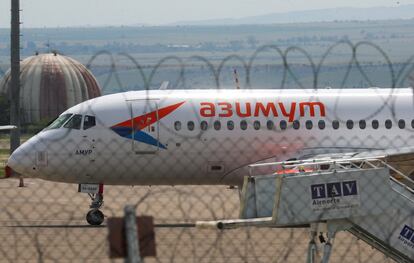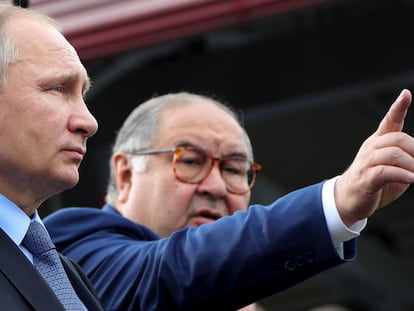Sanctions threaten Russian aviation safety: Expired components and concealed malfunctions
A number of leaks expose the risks taken by the companies, like the 2,000 flights that took off with outdated parts


Russian airplanes continue to fly in the midst of the storm. The country’s airlines transported 95.1 million passengers last year, and their volume of activity has further increased this year. Sanctions as a result of the invasion of Ukraine have made it impossible for Russian companies to purchase certain spare parts to maintain their aircraft since February 2022, but it seems that nothing has changed for the passengers. However, a series of leaks has uncovered the industry’s negligence in ensuring safety. Inspections by a Transportation Ministry agency called Rostransnadzor have revealed that at least 2,000 flights took off with components that had passed their operational lifespan. What’s more, a new investigation has found that Russia’s flagship airline Aeroflot instructed its aircraft personnel not to record in-flight malfunctions unless specifically directed to do so by the captain.
Rostransnadzor head Viktor Basarguin spoke plainly at a meeting on May 16. “It is impossible to import a number of specific products. As a consequence, numerous aircraft operations have been performed involving irregularities that directly affect flight safety. For instance, they have been allowed to operate with expired components. More than 2,000 of these flights have been recorded,” said the top official in an audio file accessed by the Kommersant newspaper.
Although this figure may seem relatively modest compared to the 1.4 million flights that crossed Russian airspace last year, the irregularities are arousing suspicions in an industry that has been crippled by sanctions. The investigative website Proekt Media — declared an undesirable organization by the Kremlin — has revealed that Aeroflot, Russia’s flagship airline, sent a letter to flight attendants in March 2022 instructing them not to record in-flight malfunctions without the permission of the aircraft’s captain.
According to former company employees contacted by this newspaper, before the war it was compulsory to report any incidents, but following the sanctions they were told to only notify the aircraft commander verbally. The website provides an example of an Aeroflot flight from the United Arab Emirates that did not carry all the oxygen cylinders required in the event of depressurization. The captain did not register this because it was deemed “an insignificant problem.”
Temporary fixes to remedy the problems
A modern fleet, a stock of components stockpiled before the war, in addition to others smuggled in from Central Asia, China and the United Arab Emirates, are the reasons why Russian airlines have been able to keep operating up to the present day. Yet this is just a temporary fix. The planes require ongoing maintenance and plans to replace Boeing and Airbus with domestic models will likely require at least a decade to implement. The pressure is overwhelming, and Russian President Vladimir Putin has pushed for production to begin immediately on aircraft whose final design is not yet complete.
Notwithstanding the sanctions, Russia is still a member of the International Civil Aviation Organization (ICAO), a U.N. agency founded in 1944 for the coordination of safety rules. Although the country was expelled from the governing council in October 2022 as a result of the danger sparked in Ukrainian skies, it retains its membership in the agency.
Before the outbreak of war, Russian aircraft were audited and certified by civil aviation representatives from Bermuda and Ireland, and Airbus and Boeing garages were responsible for maintenance. When Russia was hit with sanctions, it issued its own airworthiness certificates as a member of the ICAO. In addition, it registered two thirds of the fleet on its territory that had previously been licensed abroad, thereby assuming the supervision of the aircraft without the cooperation of the manufacturers.
This double registration is prohibited by ICAO, and the agency has red-flagged Russia highlighting “significant safety concerns” relating to “the state’s ability to adequately monitor aircraft under its jurisdiction.” Both Ireland and Bermuda reported that aircraft are currently flying without legitimate operational certificates.
Nevertheless, the U.N. agency insists that it is not its job, but that of each country, to approve or reject these certificates. “The ICAO is not a regulatory authority. The regulation of air transport is the responsibility of each state,” sources from the organization told this newspaper.
As a consequence, Russian airlines continue to fly to certain countries, including Turkey and the United Arab Emirates, where civil aviation authorities are turning a blind eye to the situation. “These nations are taking a reputational risk rather than an operational one because the civil aviation authority responsible is the Russian one,” a source in the Spanish airline industry told EL PAÍS. “The case of Turkey is a clear instance of opportunism. If an incident should occur, it may damage its image, but it makes a substantial amount of money,” they added.
Roman Gusarov, head of the Russian website Aviation Explorer, told EL PAÍS over the phone: “There are some types of maintenance that are not carried out in Russia. For example, extensive engine repairs.” Consequently, Russian civil aviation is approving situations that would have been unthinkable before the conflict began.
Proekt has displayed photos of the servicing of a giant Russian A330-300 in Iran, a country that has seen numerous accidents since it has been subject to sanctions, starting some 40 years ago. Indeed, all indications suggest that Tehran could take over the so-called big Russian stops, the C checks — every two years — and D checks — approximately every six years — where aircraft are disassembled and thoroughly inspected by Boeing and Airbus.
Meanwhile, Russia’s largest airlines have grounded over 10% of their fleets for more than three months, according to data from Flightradar 24. This could be an indication that these airliners may have been dismantled for the replacement of parts for other planes. Nonetheless, this is the least of the problems. “‘Cannibalization’ is a common practice and is more widely accepted than the use of unofficial or non-manufacturer approved parts,” clarifies the Spanish expert, although he envisages a bleak future for Russian airlines once the European skies open up again: “Their aircraft will bear unauthorized modifications and will not be allowed to fly.”
Putin blasts his government
Moscow’s plan is for the country to acquire new domestically produced aircraft and then lease them to the airlines, though the factories remain at a standstill. “The plants need to know how many civilian aircraft will be requested! Some companies don’t even have orders for 2023!” Putin spat to his Minister of Industry and Trade, Denis Manturov, during a public videoconference in the middle of January.
“I know that the companies do not have contracts, I have been told so by their directors,” the Russian president retorted. The minister, who had presented more optimistic forecasts for the industry, tried to counterbalance the situation. “The documentation will be ready within one quarter, depending on the opportunities that emerge in the budget,” responded Manturov. “In one month. Which quarter? What are we talking about? Can’t we see the conditions we are experiencing?” Putin snapped.
However, the Russian industry has to redesign aircraft in consideration of the sanctions. Besides “resurrecting” the Soviet Tu-214, the biggest projects involve the Yakovlev MC-21 and the Sukhoi Superjet 100. The latter was originally designed using more than 70% of foreign-made components.
“Preliminary contracts [with manufacturers] are already in place, but binding contracts involve meeting some basic conditions,” explained the head of Aviation Explorer. “The first is to identify the product’s features; the second is to know when it will be delivered; and the third is to determine the price. Since the aircraft are still being designed, the industry cannot answer any of these questions,” added Gusarov, who is also a member of Aeroflot’s executive board.
“An airline cannot acquire an aircraft if it does not know what it will ultimately look like. This will be clear by 2024, when mass production begins,” said Gusarov, who estimates that replacing the fleet will take about a decade.
One of the biggest stumbling blocks for Russian aviation is the engines. The head of the state corporation Rostej, Sergey Chemezov, has vowed to have the PD-8 engine ready this year to replace the Russian-French SaM-146 engine currently installed on the Superjet 100. Its concept design was unveiled in 2021, just two years ago.
“Under normal circumstances, it can take six to seven years to design, manufacture and certify an engine. The Russian authorities may accelerate it as a matter of necessity,” explained the Spanish expert. “Russia already manufactures certain engines, but their performance is a long way from those of today’s conventional commercial aircraft, General Electric and Rolls-Royce, the world’s two leading manufacturers,” he added.
The clock is ticking against the airlines. According to the daily RBK, six airlines have warned Moscow that Superjets may soon be grounded as they are running out of engine spark plugs as a result of the sanctions.
Sign up for our weekly newsletter to get more English-language news coverage from EL PAÍS USA Edition
Tu suscripción se está usando en otro dispositivo
¿Quieres añadir otro usuario a tu suscripción?
Si continúas leyendo en este dispositivo, no se podrá leer en el otro.
FlechaTu suscripción se está usando en otro dispositivo y solo puedes acceder a EL PAÍS desde un dispositivo a la vez.
Si quieres compartir tu cuenta, cambia tu suscripción a la modalidad Premium, así podrás añadir otro usuario. Cada uno accederá con su propia cuenta de email, lo que os permitirá personalizar vuestra experiencia en EL PAÍS.
¿Tienes una suscripción de empresa? Accede aquí para contratar más cuentas.
En el caso de no saber quién está usando tu cuenta, te recomendamos cambiar tu contraseña aquí.
Si decides continuar compartiendo tu cuenta, este mensaje se mostrará en tu dispositivo y en el de la otra persona que está usando tu cuenta de forma indefinida, afectando a tu experiencia de lectura. Puedes consultar aquí los términos y condiciones de la suscripción digital.
More information
Archived In
Últimas noticias
There is as much life left to discover on planet Earth as that which is already known
Dozens presumed dead, around 100 injured in fire at Swiss Alps bar during New Year’s celebration
Is porn for women different from conventional porn? We spoke to those who make it
Cartagena de Indias is sinking: What can the city do to mitigate it?
Most viewed
- David King, chemist: ‘There are scientists studying how to cool the planet; nobody should stop these experiments from happening’
- Reinhard Genzel, Nobel laureate in physics: ‘One-minute videos will never give you the truth’
- Oona Chaplin: ‘I told James Cameron that I was living in a treehouse and starting a permaculture project with a friend’
- Sinaloa Cartel war is taking its toll on Los Chapitos
- The Interoceanic Train, the Mexican alternative to the Panama Canal









































